Wildlife watch: Late fall features living gems in Bay Area
Salamander and insect biodiversity thrives in our local communities
The La Niña winter climate pattern, defined by colder weather in the Pacific region, announced its arrival last month with its entourage of clouds and rain. With this change comes new life regenerating and re-emerging in the cool, damp caress of wintertime. Below are some salamander and insect species you can see on hiking trails around the Bay Area. Even common trails at Villa Montalvo, Rancho San Antonio and Mount Umunhum harbor abundant biodiversity!
Salamanders are a diverse order within the amphibians, a group that also includes frogs and toads. Like most amphibians, salamanders typically prefer living in damp conditions. As a result, salamanders are most frequently visible during the rainy season in California. During the hot, dry summer months, they remain dormant in underground burrows. In the daytime or when it is not actively raining, you can most easily find them in moist soil under logs. Make sure to disinfect the bottoms of your shoes by spraying them with alcohol if you wander off-trail, as salamanders and other amphibians are highly susceptible to numerous pathogens. A new deadly fungal outbreak was reported just at the end of November.
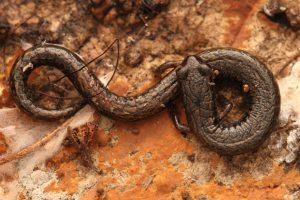
Batrachoseps attenuatus: California slender salamander
The California slender salamander is a lungless salamander; it breathes through its skin. Unlike other amphibians, most lungless salamanders hatch into miniature adults rather than tadpoles, so they don’t require access to a body of water to reproduce. B. attenuatus is a tiny common salamander the width of a shoelace. Possessing an extremely slow metabolism, it can survive on just a few dozen flies per year.
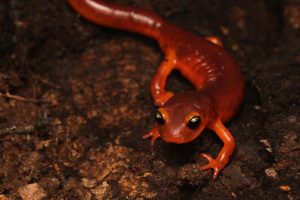
Ensatina eschscholtzii ssp. xanthoptica: Yellow-eyed ensatina
The ensatina is another lungless salamander. This particular subspecies, native to the Bay Area, mimics brightly colored poisonous newts. The grooves along the sides of this salamander (as well as others) increase the surface area of the skin for gas exchange. Ensatinas and other lungless salamanders have a bone in their tongue that allows them to shoot out their tongues nearly a body length away within a fraction of a second, enabling efficient capturing of prey.
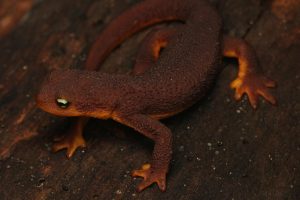
Taricha torosa: California newt
The California newt possesses a bright yellow-orange underside to warn predators and intimidate competitors. Newts are a group of rough-skinned salamanders, and unlike other amphibians, they metamorphose twice: first from an aquatic larva to a terrestrial juvenile and then back to a primarily aquatic mating adult. Adult members in the genus Taricha alternate annually between a terrestrial nonmating phase and an aquatic mating phase, during which their skin smoothens and their tails flatten to accommodate a swimming lifestyle. Newts produce from their skin the same toxin found in pufferfish, but they are only deadly if their toxins are ingested or enter the body through a cut in the skin. The genus Taricha is particularly poisonous, so resist the urge to lick them!
Next up are a variety of insects that form plant galls—abnormal swellings they signal plants to produce to house their developing young. Several groups of insects can produce galls; after they lay their eggs inside a stem, leaf, bud, or fruit, secreted chemicals induce the surrounding plant tissue to swell up, providing shelter and nutrients for the enclosed larvae. Many galls are most conspicuous in the fall when they reach their full size and mature adults emerge. Because the structure of each gall is highly specific to each species, such insects can readily be identified by their galls alone.
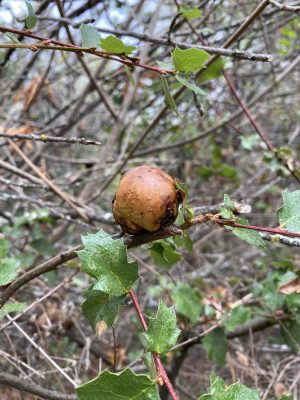
Andricus quercuscalifornicus: California gall wasp
Wasps of this species are some of the largest in the gall wasp family. Their correspondingly hefty galls can exceed the size of a golf ball, earning them the nickname “oak apples.” These large outgrowths can simultaneously host multiple larvae at various stages in development. Because some birds can feed on these galls and other insects and fungi can cohabit with the wasp larvae, this species is an important ecosystem engineer.

Andricus crystallinus: Crystalline gall wasp
This unusual, readily recognizable gall appears at first glance to be a single large, spiky mass growing on the surface of oak leaves. Upon closer inspection, it becomes apparent that these growths consist of large clusters of finely hairy pink-and-white galls. A second spring-emerging generation usually produces smaller, less clustered galls.
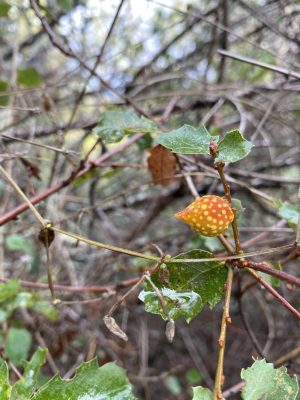
Burnettweldia plumbella: Beaked twig gall wasp
This species, around a centimeter across, is readily identifiable by its brightly colored, speckled galls that end in a beak-like point. This gall wasp infects several species of oak and primarily appears on young stems.

Rhopalomyia californica: Coyote brush bud gall midge
This gall appears on the budding tips of coyote brush, a common denizen of California chaparral. It is produced by a midge, which belongs to a group of insects more closely related to flies than wasps—an example of convergent evolution of gall inducement. The galls initially appear green and mature to a bright magenta-purple. The adults mate, lay their eggs and die all within a 24-hour period after emerging.

Nicholas Wei (11) is the managing editor of Humans of Harker. During his third year on staff, Nicholas looks forward to bonding and working with the cubs...


















![“[Building nerf blasters] became this outlet of creativity for me that hasn't been matched by anything else. The process [of] making a build complete to your desire is such a painstakingly difficult process, but I've had to learn from [the skills needed from] soldering to proper painting. There's so many different options for everything, if you think about it, it exists. The best part is [that] if it doesn't exist, you can build it yourself," Ishaan Parate said.](https://harkeraquila.com/wp-content/uploads/2022/08/DSC_8149-900x604.jpg)




![“When I came into high school, I was ready to be a follower. But DECA was a game changer for me. It helped me overcome my fear of public speaking, and it's played such a major role in who I've become today. To be able to successfully lead a chapter of 150 students, an officer team and be one of the upperclassmen I once really admired is something I'm [really] proud of,” Anvitha Tummala ('21) said.](https://harkeraquila.com/wp-content/uploads/2021/07/Screen-Shot-2021-07-25-at-9.50.05-AM-900x594.png)







![“I think getting up in the morning and having a sense of purpose [is exciting]. I think without a certain amount of drive, life is kind of obsolete and mundane, and I think having that every single day is what makes each day unique and kind of makes life exciting,” Neymika Jain (12) said.](https://harkeraquila.com/wp-content/uploads/2017/06/Screen-Shot-2017-06-03-at-4.54.16-PM.png)








![“My slogan is ‘slow feet, don’t eat, and I’m hungry.’ You need to run fast to get where you are–you aren't going to get those championships if you aren't fast,” Angel Cervantes (12) said. “I want to do well in school on my tests and in track and win championships for my team. I live by that, [and] I can do that anywhere: in the classroom or on the field.”](https://harkeraquila.com/wp-content/uploads/2018/06/DSC5146-900x601.jpg)
![“[Volleyball has] taught me how to fall correctly, and another thing it taught is that you don’t have to be the best at something to be good at it. If you just hit the ball in a smart way, then it still scores points and you’re good at it. You could be a background player and still make a much bigger impact on the team than you would think,” Anya Gert (’20) said.](https://harkeraquila.com/wp-content/uploads/2020/06/AnnaGert_JinTuan_HoHPhotoEdited-600x900.jpeg)

![“I'm not nearly there yet, but [my confidence has] definitely been getting better since I was pretty shy and timid coming into Harker my freshman year. I know that there's a lot of people that are really confident in what they do, and I really admire them. Everyone's so driven and that has really pushed me to kind of try to find my own place in high school and be more confident,” Alyssa Huang (’20) said.](https://harkeraquila.com/wp-content/uploads/2020/06/AlyssaHuang_EmilyChen_HoHPhoto-900x749.jpeg)


